
Conversational support isn’t just a nice-to-have – it’s make or break
Not too long ago, customer support was viewed as a cost center, not a value driver.
It was seen as a necessary part of a business, but not something that drove revenue or influenced customers’ buying decisions.
That time is over. Study after study shows how important a great customer experience is to today’s consumers. According to one Microsoft Global State of Customer Service report, 90% of consumers surveyed said that customer service is an important factor in their choice of, and loyalty to, a brand, while nearly two-thirds (58%) would sever their relationship with a business due to poor customer service. Another survey reveals that 84% of businesses report an uplift in revenue as one of the primary benefits of improving their customer experience.
And while this increased emphasis on customer experience and support has been underway for some time now, it has been massively accelerated by this past year. The pandemic has transformed the way we do business and build relationships with customers – highlighting the need for digital-first solutions and personalized, conversational messaging. As a result, great customer support has gone from a nice-to-have to a must-have – and investing in customer support is now critical to customer retention and business resiliency.
To respond to this new customer support landscape, many forward-thinking, customer-centric businesses have already made the leap to conversational support. Conversational support is the modern way to provide efficient, personal support at scale via messaging-based, context-rich interactions. It helps you to build longer-lasting relationships with your customers, while simultaneously empowering your support team to balance great customer experience with efficiency.
We commissioned Forrester Consulting, an independent research firm, to learn more about how conversational support is changing the industry. They surveyed over 500 global customer support decision-makers to explore how conversational experiences are fuelling customer retention and business growth for major companies.
What became clear over the course of this research is that conversational support isn’t the “future of support” – it’s the present. And with 71% of support leaders saying that scaling conversational support is necessary in order to stay competitive or become an industry leader, making the switch has never been more urgent.
This is the final post in our series exploring the findings from Drive Conversational Experiences for a Future-Ready Customer Support Strategy, a commissioned study conducted by Forrester Consulting on behalf of Intercom in April 2021. You can read the other posts in this series here.
Here’s why businesses are turning to conversational support, and how you can start leveraging it to become an industry leader.
Conversational support is the new normal
According to Forrester’s research, half of all customer support leaders either already provide conversational support or will invest in providing it over the next year.

We already know that customer expectations are higher than ever. Forrester’s study shows that support leaders are confident that conversational support allows them to address customers’ demand for fast, efficient, personalized support in a scalable way.
“Conversations are what make us human. They drive connection, they create empathy, and they increase impact through setting a context.”
That’s because conversational support leverages automation and bots so that teams can focus on what really matters: building long-lasting relationships with customers.
“Conversations are what make us human,” says Valentina Thörner, Head of Product at Klaus. “They drive connection, they create empathy, and they increase impact through setting a context. As a result, conversational support creates a more meaningful interaction with customers. It connects us to the customer long after the conversation has been closed out.”
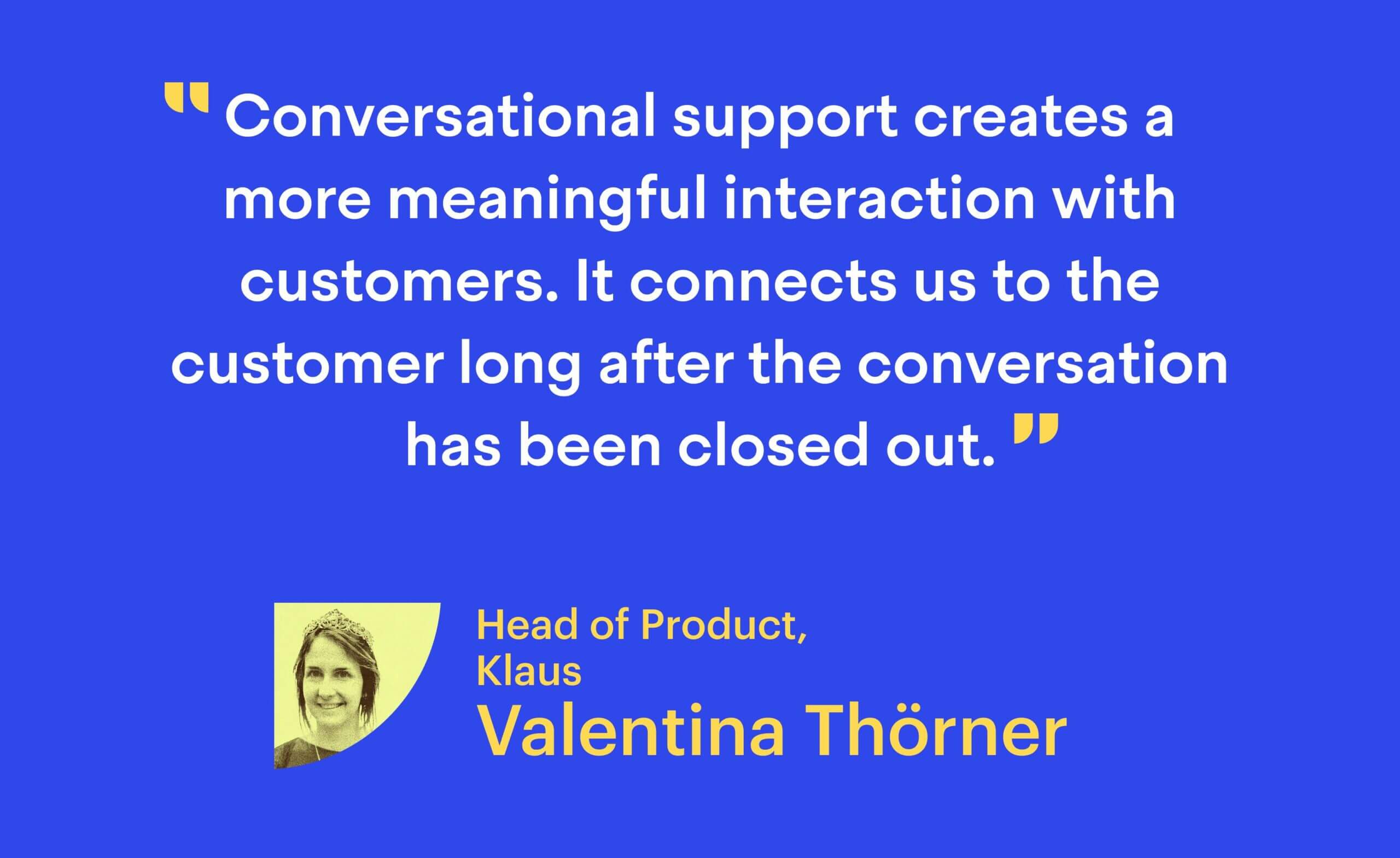
And if you’re not providing that kind of above-and-beyond support? There’s a 50% chance that your competitors are.
The concrete benefits of conversational support are clear
According to Forrester’s research, conversational support has led to some pretty incredible results. The top and most impactful benefits support leaders have reported from scaling conversational support across their organization are:
- Improved customer retention (60%)
- Increased business efficiency (58%)
- Enhanced customer satisfaction (58%)
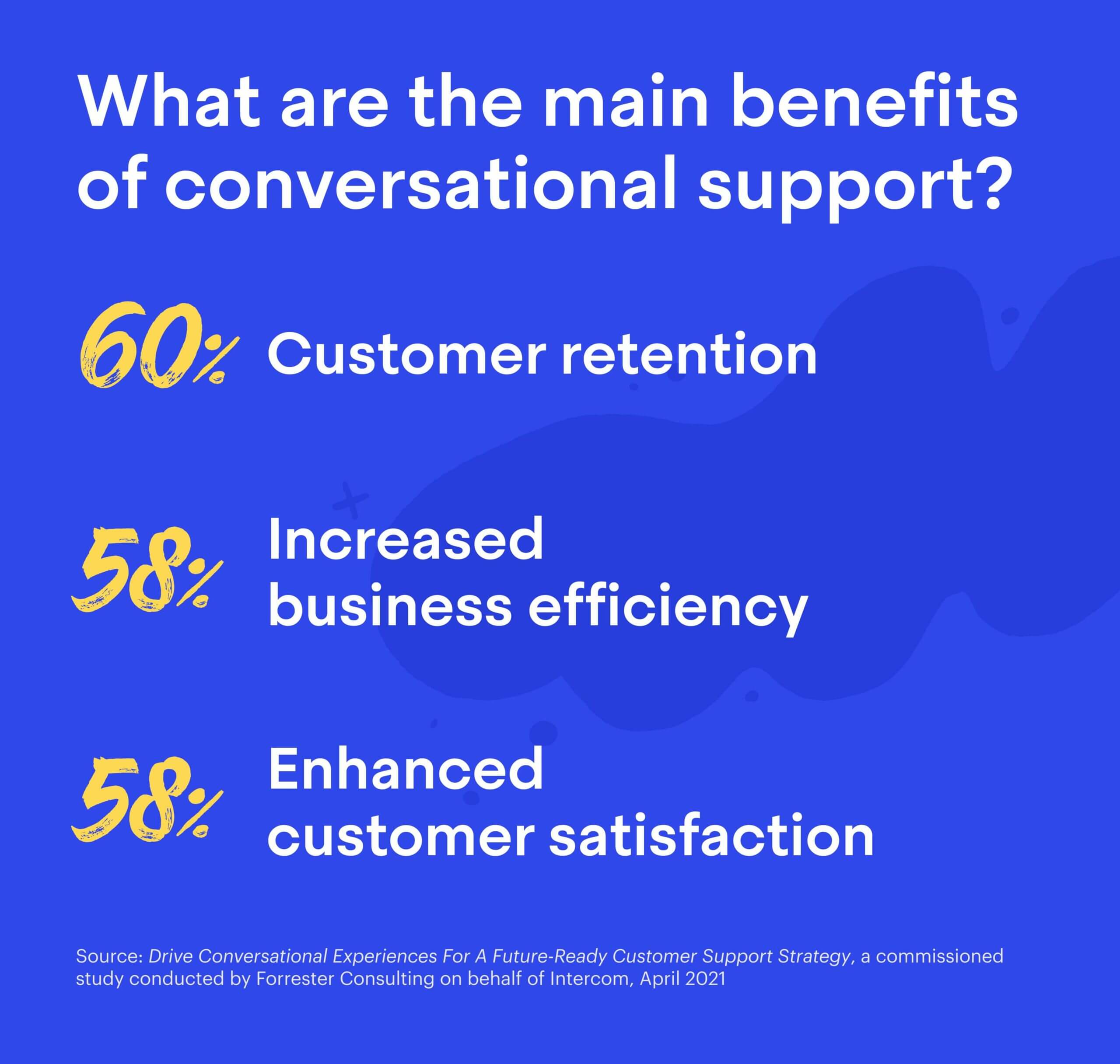
“Using conversational support techniques helps us to maintain a CSAT [customer satisfaction] score of 96% – or even higher! – and collect positive reviews from our customers,” says Vlada Masevich, Head of Customer Success at Survicate.
It’s also been instrumental in demonstrating just how much value support teams are bringing to the table. In the wake of the increased pressure placed on businesses by the pandemic, 73% of respondents say that customer support is now recognized as a more important function in their company.
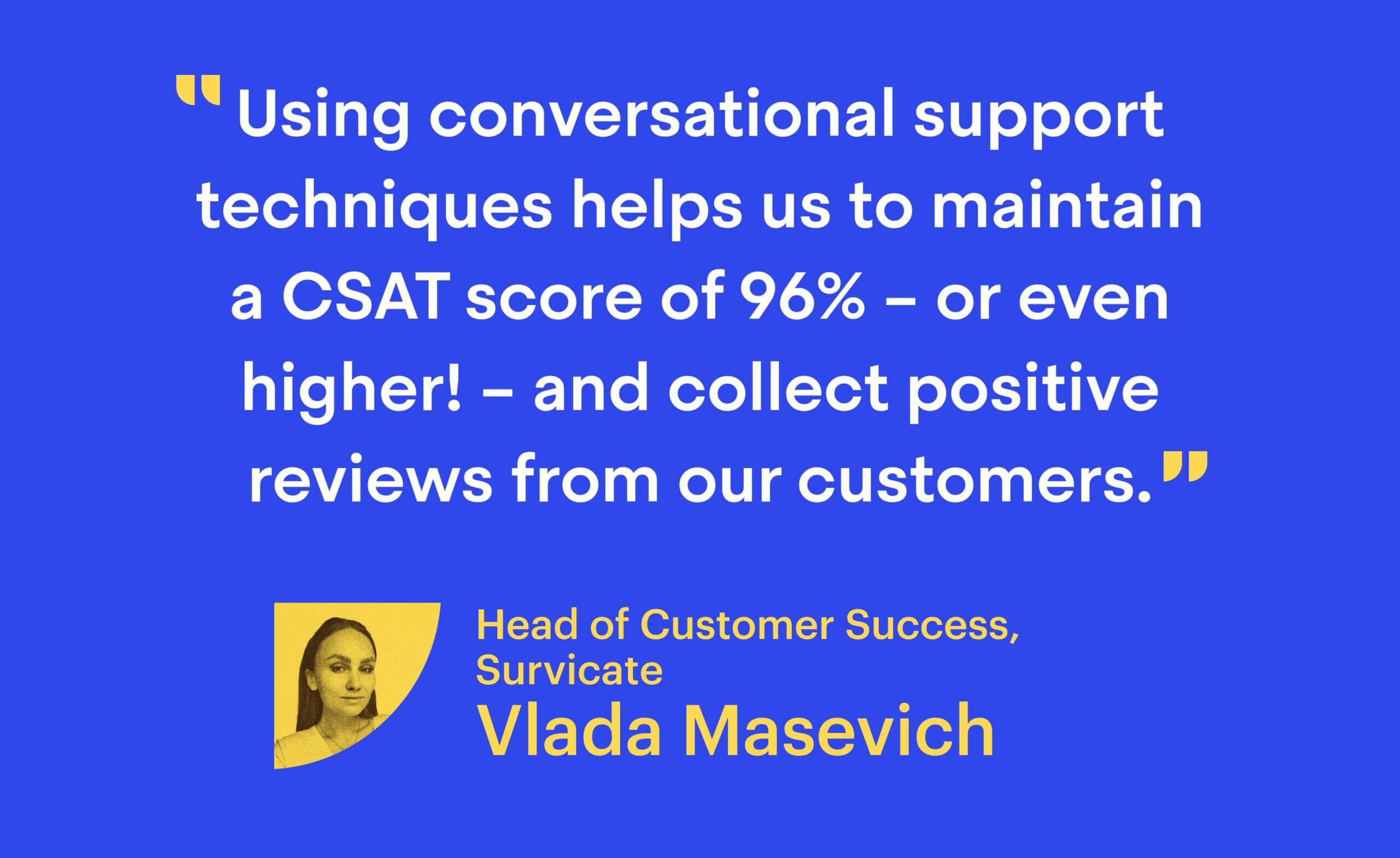
Conversational support positively impacts your whole business
But it’s not just support teams that feel the benefits of conversational support. The research shows that conversational support has significant knock-on effects for the rest of your business, too.
In a crowded marketplace, 32% of respondents say that being able to scale their support has given them increased differentiation or advantage relative to competitors. Similarly, 26% of support leaders have reported enhanced brand loyalty as a result of their conversational support offering.
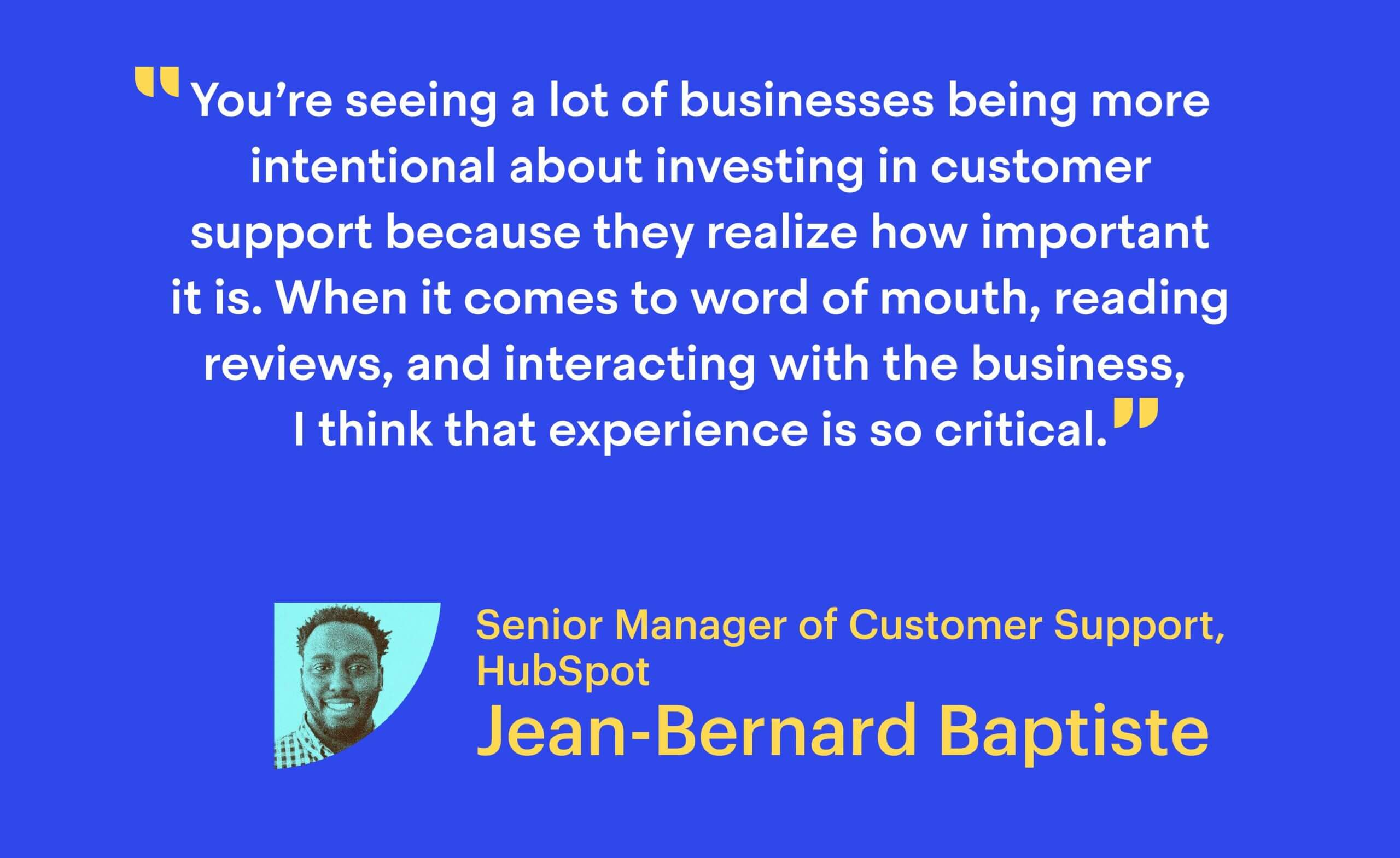
For Jean-Bernard Baptiste, a Senior Manager of Customer Support at HubSpot, this makes sense. “You’re seeing a lot of businesses being more intentional about investing in customer support because they realize how important it is,” he says. “When it comes to word of mouth, reading reviews, and interacting with the business, I think that experience is so critical.”
“29% of respondents say that scaling support across their organization empowers them to make better informed business and product decisions”
In addition to improving overall customer sentiment, we’re also seeing that conversational support can provide valuable customer insights that can be used across the entire business. Almost a third (29%) of respondents say that scaling support across their organization empowers them to make better informed business and product decisions.
How do you become an industry leader in support?
It’s clear that conversational support is now business-critical. Customers want it. Support teams want it. And, with all of the additional benefits for your organization as a whole, you can be sure your stakeholders want it, too.
So how can you start to future-proof your business and make the switch to conversational support? If you want to become an industry leader, here are three things to do now.
1. Invest in the right tools and frameworks
We’ve already seen that inefficient tools are one of the biggest barriers to providing conversational support at scale. Less than half (46%) of support decision-makers believe they can deliver personalized customer support at scale with their current technology stack.
“Investing in a quality customer support tool is an investment in your customers’ happiness”
Investing in a quality customer support tool is an investment in your customers’ happiness. With a messaging-based conversational support tool, you can provide fast, efficient, personal support that meets your customers’ needs for personalization, while simultaneously empowering your team behind the scenes.
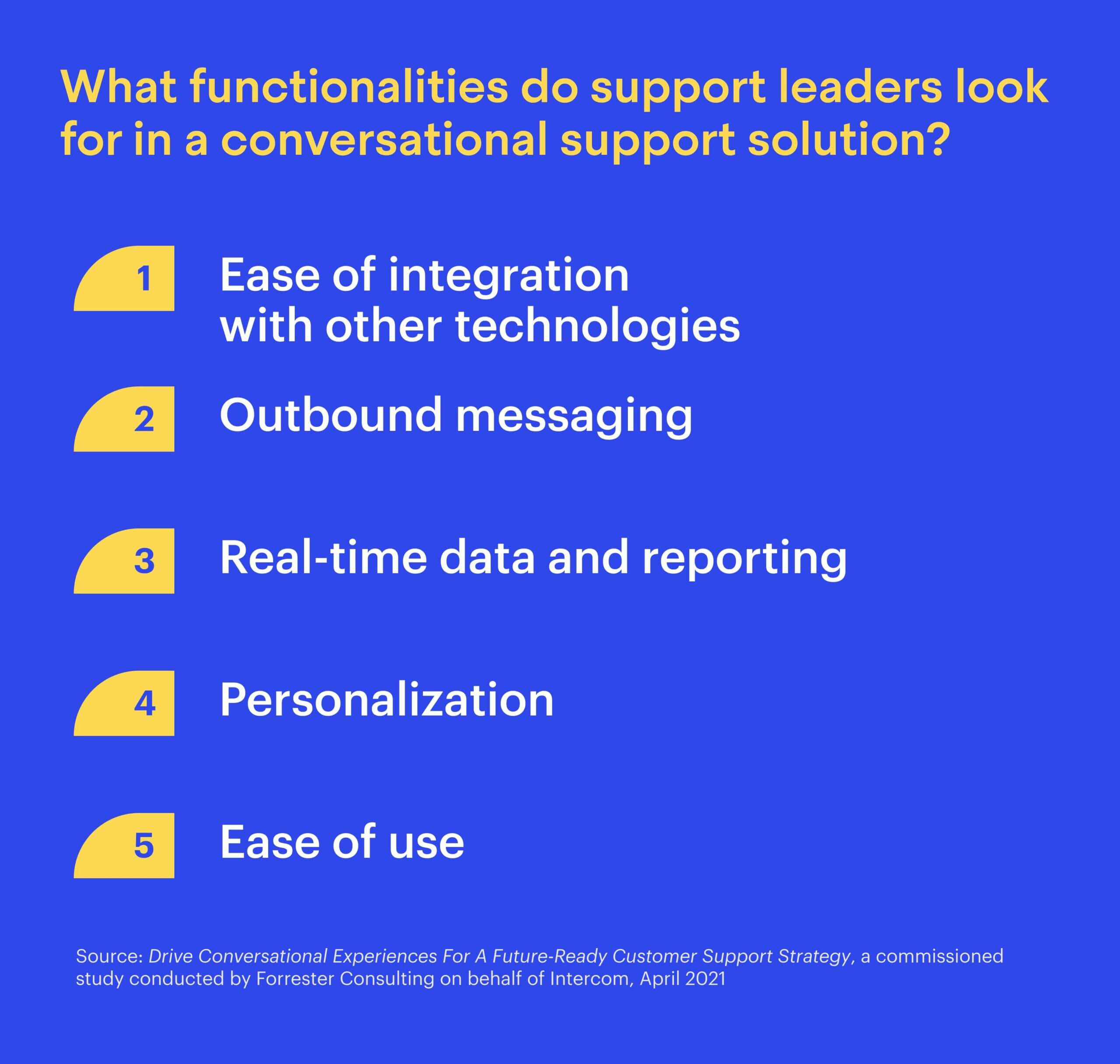
The key functionalities support leaders look for in a conversational support solution?
- Ease of integration with other technologies (76%)
- Outbound messaging (70%)
- Real-time data and reporting (69%)
- Personalization (66%)
- Ease of use (66%)
But technology is still only one piece of the puzzle. That’s why we use the Conversational Support Funnel. The Conversational Support Funnel is our messenger-first framework that uses a clever combination of self-serve, proactive, and human support to set your team and your customers up for success.
For Grayson Bagwell, Director of Business Development at Rugs.com, using the right tool with the right framework has allowed his team to supercharge their efficiency tenfold – and make incredible savings. “When we were calculating the labor we’d need to meet our goals last year, we forecasted needing 100 people,” he says. “With the help of Intercom, we were able to achieve those goals with a team of 40.”
2. Start planning how your workforce will evolve
As automation and bots become more commonplace, we’re going to see some changes in the nature of the support rep role. So where do we go from here?
Luckily, the introduction of bots and automation is a good thing for support reps. In fact, Forrester’s research shows that 32% of respondents report increased agent satisfaction as a benefit of scaling conversational support. That’s because by taking the repetitive, easy-to-answer questions off your support reps’ plates, they’re free to focus on more impactful queries.
The human layer of the Conversational Support Funnel is the most important layer for a reason: for technically complex or emotionally charged conversations, there’s simply no substitute. As Valentina at Klaus says, “For complex support requests, human conversations can reframe expectations and address emotions.”
“Conversational support allows us to connect with real people”
That means that as you start to think about the future of your support team, you need to focus on the unique skills and knowledge that only a real person can provide. That means prioritizing empathy and emotional awareness, training them with in-depth technical knowledge, and equipping them with the right tech stack to help them to succeed.
And by focusing on the human stuff that only a human can do, you can make your support reps’ jobs more fulfilling. “Conversational support allows us to connect with real people,” says Valentina. “The main purpose is still solving the customer problem, and at the same time it allows to add personality to the conversation – on both sides. This makes the conversations more interesting, and often more joyful for everyone involved. Ending a support interaction with an on-point GIF exchange feels great, and this feeling persists even after the conversation is over.”
3. Re-evaluate how you measure support success
There are a ton of different metrics you can track when it comes to customer support – but are you tracking the ones that actually reflect your business goals?
As you pivot to a more conversational approach, it’s important to rethink your key performance indicators (KPIs) to make sure they’re in line with your priorities. For example, if your team is being measured by how quickly they can close conversations, you might find that your KPIs are prioritizing short-term speed over long-term solutions that are specific to each customer’s use case.
Similarly, if you’re looking for customer satisfaction, your team’s performance can be at the mercy of someone’s frustration with your product (or even just their bad day). But if you’re also taking an internal quality score into consideration, you can be confident that you’re still meeting your own high standards.
That’s why we recommend tracking a few metrics to give a fuller picture of how your team is performing and understand how you’re measuring up against industry benchmarks.
“Last year, our rate of automated resolution was around 5.5%, which translated to over half a million dollars in savings”
As you move to a conversational support approach, it’s also important to think about ways you can demonstrate its unique ROI. Think about how you can measure the success of your self-serve and proactive support strategies, such as tracking how many conversations are closed by your help center articles.
At Intercom, we use a metric called the rate of automated resolution (ROAR), which measures the percentage of all customer issues that are resolved without human involvement. Every percentage translates to approximately $100,000 saved. Last year, our ROAR was around 5.5%, which translated to over half a million dollars in savings.
With the right metrics in place, you can not only align to a more customer-centric, conversational mindset, but also start to meaningfully measure (and report) the impact that this approach is having on other areas of the business – like its bottom line.
Learn more about how conversational support can future-proof your business
Want to dig deeper into Forrester’s research to see how conversational experiences can drive business growth and unlock new opportunities? Download your copy of the study now.






